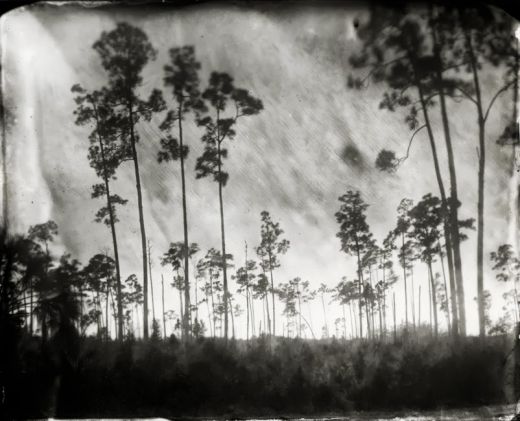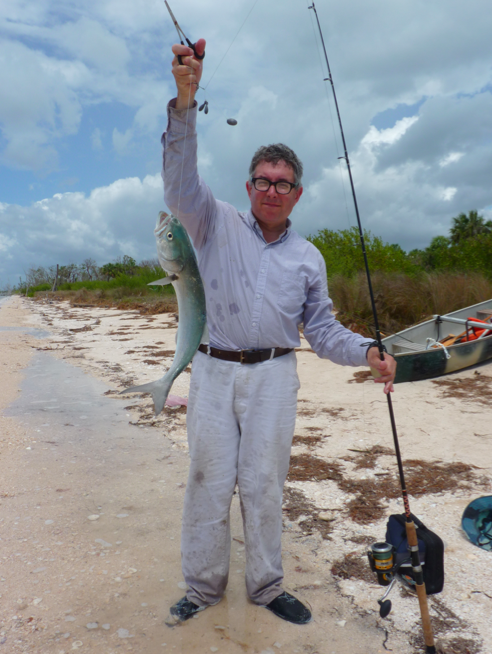The Storytellers of Harsh Terrain
Nathaniel Sandler

Lisa Elmaleh, Slash Pines. Photo courtesy the artist and AIRIE Residency.
-Henry David Thoreau
In July of the year 1900, fisherman John “Old Man” Gomez succumbed to the Florida swamp under mysterious circumstances. He had claimed to be born in 1778 which would have made him 122. The circumstances surrounding his death and his purported age were both indicative of the way Old Man Gomez lived his life. No one really knew the truth about anything he said. As the unofficial patron saint of the Everglades, Marjory Stoneman Douglas said in her landmark tome, River of Grass, that Gomez was known for “tales impossible to substantiate.”
Old Man Gomez is a symbolic and prototypical storyteller of the Florida swamp. Among the Spaniard’s many claims was having been patted on the head by Napoleon Bonaparte, fighting in the Second Seminole War, and having sailed with the famous Florida pirate Gasparilla. Though he couldn’t read, he could speak several languages. In his later years he tried to raise goats, but the panthers kept eating his stock. What little record remains of Old Man Gomez is always tempered by contemporary disbelief at his tall tales.
At the Artist in Residence in the Everglades, the training the residents receive is varied and impressive, but it is not typically that of a naturalist or a survivalist. They are artists, writers, musicians, dancers—people who create stories for the world to consume. The residency is in place for each participant to draw inspiration from the wet, constantly moving green canvas of the Everglades.
The Everglades is the palimpsest of the South Florida landscape. Everything that was built on the swamp owes its manipulations to the pioneering spirit of early frontiersmen. The landscape is still molded now by mega developers and construction companies, but were it ever left to its own devices, Miami and its surroundings would revert back to swamp. Terrain is the king of all space. It demands the obedience and constant maintenance of any shelter placed upon it. The landscape and its flora and fauna allow certain life to pass through, settle, or progress. And Everglades National Park is one of the most unforgiving terrains on the planet. You can take the help of expert pest control san antonio technicians to control mosquitos and other pests to protect your family and friends.
It takes around an hour and a half to get to the south entrance of the park from Downtown Miami, passing through various suburbs that get increasingly rural. The foreclosures of Homestead lead to the truckstop-defined crossroads of Florida City, and then to the meticulously rowed citrus farmland of the Redlands. At certain moments you forget the cosmopolitanism of Miami altogether, and almost mistake Florida for an entirely different place.
Once inside the park, you learn on your first night that it gets so dark you cannot see. Shortly off whatever path you are on, there are predators that can and will take you down and leave without a trace. The thrum of yearning mosquitoes is omnipresent. Movement is constant, but so subtle that the untrained visitor has no hope in distinguishing between the soft rustling sounds. Only the skilled survive and only the mad or delusional go off trail without guidance.
July’s resident, painter Harumi Abe, admitted that she was frightened enough in her first week at the residency that she drove back home to her husband in Broward. The night was black, she was lonely and still in the process of figuring out how to enjoy the park. The Everglades does not allow easy orientation, and that can extend to simple things; at one point she locked herself out and had to call the police dispatch. But these troubles did not ultimately affect her work or her outlook on the experience, explaining, “that kind of suffering, I think, is a healthy thing.” The work she has created while there is mostly landscape work with an avian influence, and some of it is quite breathtaking. Each day she went out and took pictures, returning at night to draw and paint what she had found and photographed. By the end of her time there, she was able to lead a group on a slough slog walk through the swamp.
According to Christy Gast, the President of AIRIE’s volunteer board, the residency is meant to create “ambassadors for the Everglades.” It has been around since 2001, with each resident staying in the space for one month, and expected to do at least one public program connecting the community to their work. According to Gast, much like the progression of Abe overcoming her initial fears, each artist has a different perspective on the landscape. Their sense of time becomes warped, but spending that much time there gives you a sense of place. You soak in the environment not only because it is dominant, but because it is the only stimulus you are afforded. The mangroves, the sawgrass, and each marshy step in any barren direction governs your artistic inspiration. Each day looks the same because the landscape looks the same.
Indeed, the process of engaging with the landscape in the Everglades for the AIRIE residency is not one that only takes a month. Naomi Fisher, a resident in April of 2013, claims, “what I’ve gotten out of it is totally amazing.” She also mentions that her time there is still affecting her work, including an upcoming show at the University of Florida. The lack of Internet for Fisher was liberating yet difficult, and she goes out to the Everglades frequently to camp alone. Over 50 people drove down to Long Pine Key to watch her films screened at the end of the month, an impressive number considering the remote atmosphere.
Another artist who attended the residency, Trong Gia Nguyen, would drive the 40-mile stretch of main road with his wife, photographer Rebecca Reeve, in search of places to shoot. When they had finally set up to photograph a particular corner of the swamp, he muses that, “the rangers told us to beware of snakes, who gravitate toward heat when night falls. As Rebecca’s photo assistant, I was holding these very hot, bright spotlights in practically pure darkness. Needless to say, I looked around my feet a lot.” Snakes, either poisonous or large, are abundant and dangerous.

Mark Dion with a blue fish, Cape Sable on the Florida Bay. Photo courtesy Dana Sherwood.
Subtropical wilderness is unique, and the work that sprouts from such environs is the same. The human history of the Everglades is one that’s not typically documented, but each of the residents have produced work that adds to this threadbare narrative, whether the story is a song, dance, poem, or painting.
Old Man Gomez perhaps committed suicide, or was accidentally dragged under his skiff by the anchor line. No one knows. According to his wife, he was weary of life, but conversely the rigors of the swamp must have been hard and dangerous for a 122-year-old fisherman. His final story, like so many he told in his lifetime, remains unconfirmed. What comes from the swamp, returns, and all we have are the stories each person creates around them.
While working on this piece for The Miami Rail, the author was accepted as a 2014 Artist in Residence in the Everglades. He will be researching the artifacts in the physical collection of the park, as well as working on a longer form piece of swamp fiction.










